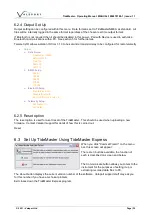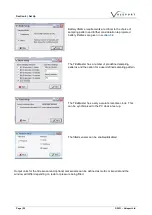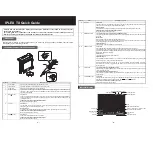
TideMaster - Operating Manual: MANUAL-1094978189-1 | issue: 1.1
© 2021
– Valeport Ltd
Page | 10
2.4 Calibration
2.4.1 Pressure Sensor
If the TideMaster is supplied with a pressure sensor, it will be shipped with a factory calibration, which
provides an output of pressure in decibars and takes out any non-linearity in the transducer characteristic.
Note that the pressure calibration is specifically for a combination of TideMaster and transducer, and the unit
and transducer serial numbers are held in the logger memory. If the transducer is changed, the pressure
calibration will be slightly in error, but the system can still be used provided an in-situ calibration of depth
against pressure output is made.
The user can add this calibration to provide output in metres [or feet] above a datum. This secondary
calibration takes the form of a
Gain factor [distance per dBar]
and
Offset [transducer position with
respect to datum]
. In order to determine this secondary calibration, some on site readings will need to be
taken to establish the relationship between decibars and depth with respect to a datum for the particular site.
The exact calibration is affected by
transducer offset, water density and gravity
.
The transducer is temperature compensated, but this compensation does rely on the temperature of all parts
of the transducer being the same, so when the transducer is first put into water, time must be allowed for the
temperature to stabilize before any calibration measurements are taken. Five minutes should be adequate.
2.4.2 VRS-20 Radar Level Sensor
The VRS-20 radar sensor measures distance to a water surface, this measurement is factory calibrated and
the calibration is held within the radar sensor. This calibration is independent of environmental conditions.
To transform this range to a tide height the offset between the Radar Datum and a Local Datum must be
established. The relationships between range, working range, tide height, radar datum and local datum are
shown in section 2.3.
2.4.2.1 Working Range
To reduce the possibility of spurious returns and improve the data quality, a valid working range can be set
on the VRS-20. The VRS-20 will ignore any returns from outside of this range so it is important to ensure the
minimum working range is set to a level above Highest Astronomical Tide and the maximum working range
to a level below Lowest Astronomical Tide.















































